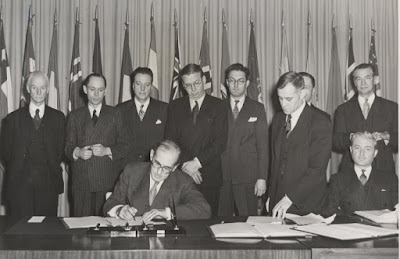(Continuing
the series on water rights - the first installment was
here.)

Property in water takes a great variety of forms. Many countries' laws state that all water is the property of the public or the state (
Trelease, 1957;
Cumyn, 2007;
Sun, 2009;
Schorr, 2013). Most civil law countries, following Roman law, distinguish between public and private waters. The "absolute dominion" rule of the common law, still in force in some American states, treats groundwater as an unowned resource, open to capture by any overlying landowner (
Dellapenna, 2013). The riparian rights system of the common law views water sources as the common property of all landowners abutting the source (
Getzler, 2004). The system of prior appropriation applied in the western United States recognizes private property rights to amounts of flows of water. In Australia (
Davis, 1968) and western Canada the Crown owns the water and distributes it to users through a permit system (
Percy, 2005). (A useful survey of most of the world's property regimes for water, including those mentioned in this paragraph, is found in Dante A. Caponera,
Principles of Water Law and Administration (2nd ed., revised & updated by Marcella Nanni, 2007).)
Though most legal systems are viewed as reflecting a view of water either as private, common, or public property, most systems in practice recognize a mix of these types of rights in water sources. For instance, often quoted (e.g. Samuel C. Wiel, "Running Water",
Harvard Law Review 22: 190 (1914)) is the statement from Justinian's Institutes (1913: 2.1.1): "The following things are by natural law common to all—the air, running water, the sea, and consequently the seashore"; yet the Roman law, in every period, contained a complex mix of private, communal, and public rights in water (
Caponera, 2007). Of Islamic water law it is said that "true Muslim believers cannot grab water in excess to their needs since they are obliged to allow free access to any amounts of water beyond these needs" (
Al-Awar et al., 2010: 32) and that the Prophet prohibited selling of water (
Caponera, 1954), but also that "Islam supports privatization of water supply… as long as it leads to a fair and free market" (Al-Awar et al., 2010: 34). The civil law's distinction between public and private waters has often ceased to exist in practice, with state approval being required for use of private waters as well as public (
Caponera, 2007). China's
constitution (Art. 9) and
2002 Water Law (Art. 3) state that all water is owned by the state, but in practice a system of private rights exists (
Wouters et al., 2004;
Shen and Speed, 2009). In the Anglo-American world much is made of the difference between the common-property rules of the riparian system in force in England and the eastern United States, and the system of private appropriative rights in the western U.S., but both systems in fact contain a mix of features typically associated with each type of property (
Smith, 2008).
If the reality of formal water rights at the level of state law is a complex mix of public, private, and common, a large body of research on water management at the local level (e.g.
Maass and Anderson, 1978;
Meyer, 1984;
Ostrom, 1990;
Rivera, 1998;
Boelens, 2008) reveals an almost infinite variety of property and governance systems. In various places water is sometimes allocated in proportion to field size, in accordance with the age of the field, by family, by position on the stream, or by any other of a multitude of possible principles, often anchored in long-standing custom and close social, economic, cultural, and religious ties. Integrating these locally embedded rights into systems of state law is a complex task, one often accompanied by significant redistributions of water rights (e.g.
Reich, 1994;
Van Koppen, 2007;
Hendriks, 2010;
Hicks, 2010;
Boelens and Seemann, 2014).
Next:
Property in water: Theory. The full article is
here.
 This is not to say environmental law has no past; indeed, scholars are beginning to uncover its historical roots. What I mean by having no history is, first, that there is a general feeling, common to legal historians and environmental lawyers (particularly in the United States), that environmental law is something new under the sun, having emerged in the 1970s from the environmental crises of the preceding decade (such as the Cuyahoga River catching fire) and a contemporaneous sharpening of ecological consciousness (spurred, most prominently, by Rachel Carson's Silent Spring). Modern environmental law lacks of connection both to earlier periods and to the great themes and trends of legal history.
This is not to say environmental law has no past; indeed, scholars are beginning to uncover its historical roots. What I mean by having no history is, first, that there is a general feeling, common to legal historians and environmental lawyers (particularly in the United States), that environmental law is something new under the sun, having emerged in the 1970s from the environmental crises of the preceding decade (such as the Cuyahoga River catching fire) and a contemporaneous sharpening of ecological consciousness (spurred, most prominently, by Rachel Carson's Silent Spring). Modern environmental law lacks of connection both to earlier periods and to the great themes and trends of legal history.


























